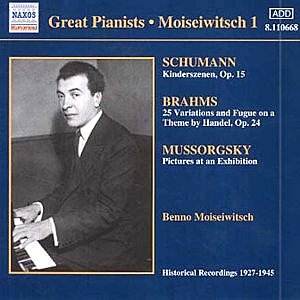 |
Great Pianists: Moiseiwitsch
Vol 1 Robert SCHUMANN (1810-1856) Kinderszenen, op. 15 (rec. 14.4.1930) Johannes BRAHMS (1833-1897) Variations and Fugue on a Theme by Handel, op. 24 (rec. 4.3.1930), Intermezzo in C, op. 119/3 (rec. 25.3.1927), Rhapsody in E flat (rec. 2.3.1928) Modest MUSSORGSKY (1839-1881) Pictures at an Exhibition (rec. 21.8.1945) Recorded in the Queen's Small Hall (Schumann, Brahms), Abbey Road Studio 3 (Mussorgsky) Crotchet AmazonUK AmazonUS Amazon recommendations |
At the start of the Schumann you will have a reminder that this is an artist of an older school, for the two hands are very far from synchronised. You will also hear that the melodic lines - treble and bass - have a wonderfully singing quality which somehow survives effortlessly the passing of 70-plus years since the recording was made, and that the triplets in the middle of the texture are ideally weighted. Thereafter you will find an enthralling display of tenderness, humour and sheer communicative warmth. Though Moiseiwitsch is in some ways very free in his phrasing and timing, the basic rhythm of each piece is still maintained - this is true rubato. Noteworthy is "Frightening" which often seems bland but which is properly scary here, and "Child falling asleep", which is unusually robust in its earlier stages, the idea being that the child falls asleep at the end, not at the beginning (with the risk that the listener will do so too).
At least as remarkable are the Brahms Variations. After a full-toned Theme, Moiseiwitsch kick-starts the Variations with what seems like a leap of joy, and never lets us forget that this is the work of a relatively young Brahms, flexing his muscles and simply rejoicing in his compositional powers. Moiseiwitsch throws himself into the faster variations with reckless abandon (and catches a few crabs, but who cares), while finding much limpid expressiveness in the more thoughtful moments and ardour (rather than tragedy) when Brahms goes into the minor key. The Fugue makes a thrillingly confident conclusion and nowhere is there any trace of extra fat or gruffness to this Brahms. These were the first recordings made of these works and, aside from the sound quality (which in spite of its limitations I found no bar to enjoyment) one wonders if they have ever been surpassed since.
Oddly, this same interpretative freedom applied to the two pieces of the older Brahms seems to reduce the music to kitsch - or did Moiseiwitsch himself mature in the two intervening years? I shall shortly be reviewing the companion to the present disc, which consists entirely of shorter pieces, so maybe I shall have further thoughts on this.
Regarding the Mussorgsky, there can be no doubt that this is another great performances, with all the required range of grandeur, humour, sarcasm and warmth. Listen to the Old Castle and hear how the melodic lines sing freely while the accompanying figures have exactly the right weight, neither intruding nor disappearing. For reasons of space (the performance had to be accommodated onto four discs) there are slight cuts in this movement and in the Great Gate of Kiev which nonetheless makes a suitably colossal finale.
A particular word of praise for the work of Ward Marston, not only in obtaining such generally pleasant sound from the discs, but also for his mounting of the pieces as a sequence. In the performance of works divided into so many sections, not the least of the artist's tasks lies in judging the exact moment in which to pass from one piece, or variation, to another. Too long a pause will give the effect of overall heaviness, too short a pause will create a sense of breathlessness. Here, of course, in linking up the 78 sides, Marston has had to rely on his own intuition, and I can only report that the results are wholly convincing. There is just one jolt, and as far as I can see nothing could be done about this. The penultimate movement of the Mussorgsky, the Hut on Fowl's Legs, is supposed to lead straight into the Great Gate of Kiev. Realising that this was impossible, Moiseiwitsch actually rounds of the Hut with a cadence. I suppose this cadence could have been cut out, but there is also a change of acoustic from one piece to the other so we just have to accept that this minor jolt is inevitable.
Still, it's wonderful to have all this available, and so cheaply. The three major works are essential listening for all who care about piano music.
Christopher Howell